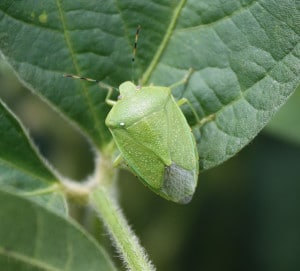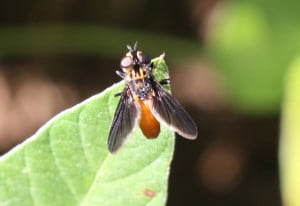 Actually, that’s an egg. In fact, it’s the egg of another insect and basically, that stink bug is doomed to an untimely and gruesome death. That egg is from a Tachinid fly (picture below). These flies are members of the insect family Tachinidae. There are approximately 1200 species of tachinids in North America alone, and almost all are parasitoids of other insects. Adults are very diverse in shape, size and color and egg-laying strategies are also very diverse within this family. In this case, the egg was “glued” onto the body of the host insect (green stink bug, Acrosternum hilare Say) by an adult fly and when the larva hatches, it burrows into the host’s body and feeds. These larvae eat their host from the inside out. Tachinid larvae exit the host body to pupate. This event has been likened to the science fiction movie “Alien” where the space creature inserted its embryo into a human host where it developed until it violently emerged at the expense of the life of the human. However, the developing alien didn’t consume the human’s entrails out beforehand, like a tachinid larva does to its host. So if you’ve seen this movie, you have a toned down view of the way things really are for an insect host of a Tachinid fly larva.
Actually, that’s an egg. In fact, it’s the egg of another insect and basically, that stink bug is doomed to an untimely and gruesome death. That egg is from a Tachinid fly (picture below). These flies are members of the insect family Tachinidae. There are approximately 1200 species of tachinids in North America alone, and almost all are parasitoids of other insects. Adults are very diverse in shape, size and color and egg-laying strategies are also very diverse within this family. In this case, the egg was “glued” onto the body of the host insect (green stink bug, Acrosternum hilare Say) by an adult fly and when the larva hatches, it burrows into the host’s body and feeds. These larvae eat their host from the inside out. Tachinid larvae exit the host body to pupate. This event has been likened to the science fiction movie “Alien” where the space creature inserted its embryo into a human host where it developed until it violently emerged at the expense of the life of the human. However, the developing alien didn’t consume the human’s entrails out beforehand, like a tachinid larva does to its host. So if you’ve seen this movie, you have a toned down view of the way things really are for an insect host of a Tachinid fly larva.
 Some Tachinids are host specific while others may have various host insects. Tachinid fly larvae are parasitoids of some of our important crop pests, including stink bugs. They are the most important family of parasitoid flies that provide us with biological control.
Some Tachinids are host specific while others may have various host insects. Tachinid fly larvae are parasitoids of some of our important crop pests, including stink bugs. They are the most important family of parasitoid flies that provide us with biological control.
References:
Marshall, S. A. 2006. Insects: Their Natural History and Diversity. Firefly Books Ltd. Buffalo, NY 14205. Pgs. 408-410.

